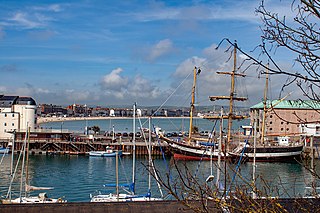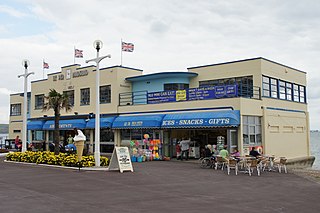
A beach is a landform alongside a body of water which consists of loose particles. The particles composing a beach are typically made from rock, such as sand, gravel, shingle, pebbles, etc., or biological sources, such as mollusc shells or coralline algae. Sediments settle in different densities and structures, depending on the local wave action and weather, creating different textures, colors and gradients or layers of material.

The Isle of Portland is a tied island, 6 kilometres (4 mi) long by 2.7 kilometres (1.7 mi) wide, in the English Channel. The southern tip, Portland Bill lies 8 kilometres (5 mi) south of the resort of Weymouth, forming the southernmost point of the county of Dorset, England. A barrier beach called Chesil Beach joins Portland with mainland England. The A354 road passes down the Portland end of the beach and then over the Fleet Lagoon by bridge to the mainland. The population of Portland is 13,417.

Chesil Beach in Dorset, England is one of three major shingle beach structures in Britain. Its name is derived from the Old English ceosel or cisel, meaning "gravel" or "shingle". It runs for a length of 29 kilometres (18 mi) from West Bay to the Isle of Portland and in places is up to 15 metres (50 ft) high and 200 metres (660 ft) wide. Behind the beach is the Fleet, a shallow tidal lagoon. Both are part of the Jurassic Coast and a UNESCO World Heritage Site, and together form an SSSI and Ramsar Site.


Swanage is a coastal town and civil parish in the south east of Dorset, England. It is at the eastern end of the Isle of Purbeck and one of its two towns, approximately 6+1⁄4 miles (10 km) south of Poole and 25 miles (40 km) east of Dorchester. In the 2011 census the civil parish had a population of 9,601. Nearby are Ballard Down and Old Harry Rocks, with Studland Bay and Poole Harbour to the north. Within the parish are Durlston Bay and Durlston Country Park to the south of the town. The parish also includes the areas of Herston, just to the west of the town, and Durlston, just to the south.

Bridport is a market town in Dorset, England, 2 miles (3.2 km) inland from the English Channel near the confluence of the River Brit and its tributary the Asker. Its origins are Saxon and it has a long history as a rope-making centre. On the coast and within the town's boundary is West Bay, a small fishing harbour also known as Bridport Harbour.

Melcombe Regis is an area of Weymouth in Dorset, England.

A beach hut is a small, usually wooden and often brightly coloured, box above the high tide mark on popular bathing beaches. They are generally used as a shelter from the sun or wind, changing into and out of swimming attire and for the safe storing of some personal belongings. Some beach huts incorporate simple facilities for preparing food and hot drinks by either bottled gas or occasionally mains electricity.

Sea bathing is swimming in the sea or in sea water and a sea bath is a protective enclosure for sea bathing. Unlike bathing in a swimming pool, which is generally done for pleasure or exercise purposes, sea bathing was once thought to have curative or therapeutic value. It arose from the medieval practice of visiting spas for the beneficial effects of the waters. The practice of sea bathing dates back to the 17th century but became popular in the late 18th century. The development of the first swimsuits dates from the period as does the development of the bathing machine.

Weymouth Bay is a sheltered bay on the south coast of England, in Dorset. It is protected from erosion by Chesil Beach and the Isle of Portland, and includes several beaches, notably Weymouth Beach, a gently curving arc of golden sand which stretches from the resort of Weymouth. Weymouth Bay is situated approximately halfway along the UNESCO Jurassic Coast World Heritage Site.

Gloucester House or Gloucester Lodge is a former royal residence on the esplanade in the seaside resort of Weymouth on the south coast of England. It was the summer residence of Prince William Henry, Duke of Gloucester and Edinburgh (1743–1805), fourth son of Frederick, Prince of Wales, and brother of King George III. During his recovery from porphyria in 1789, George III spent some time convalescing there. The king occupied the right-hand part of the building, and had use of the garden, where the later, left wing stands. His doctors encouraged him to visit the resort to benefit from the sea air and salt water. The patronage of the king was important in drawing fashionable society to the south coast town.

Ringstead is a small seaside village located on the coast in Dorset, southern England. The area lies on the Jurassic Coast and is known for its natural environment and fossils. Ringstead Bay and White Nothe are to the east. Bran Point and Osmington Mills are to the west.
Mudeford is a harbourside and beachside parish based on a former fishing village in the east of Christchurch, Dorset, England, fronting water on two sides: Christchurch Harbour and the sands of Avon Beach.

Weymouth is a sea-side town and civil parish in the Dorset district, in the ceremonial county of Dorset, on the English Channel coast of England. Situated on a sheltered bay at the mouth of the River Wey, 11 km (7 mi) south of the county town of Dorchester, Weymouth had a population of 53,427 in 2021. It is the third-largest settlement in Dorset after Bournemouth and Poole. The greater Weymouth urban area has a population of 72,802.

Weymouth Pier is a peninsula between Weymouth Harbour and Weymouth Beach, in Dorset, England. It was intended to extend Weymouth's esplanade, and consists of a theatre, Weymouth Pavilion; pleasure pier; car parking and a cross-channel ferry terminal. The entire site underwent redevelopment to include new facilities for the 2012 Olympic Games, including the Weymouth Sea Life Tower.

The Esplanade is a wide walkway and street on the seafront at Weymouth, Dorset on the south coast of England.

The Jurassic Skyline tower was an observation tower on Weymouth Pier in Weymouth, Dorset, England. It was situated next to Weymouth Beach and the Weymouth Pavilion, where it overlooked Weymouth town, the beach, the Pavilion, the Old Harbour, Nothe Gardens, the Nothe Fort, and Portland Harbour. It opened on 22 June 2012.

Royal Hotel is a 19th-century hotel at Weymouth, Dorset, England. It is located on the town's seafront, overlooking Weymouth Beach and Weymouth Bay. The building has been a Grade II listed building since 1974.
























